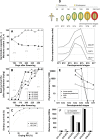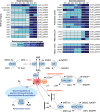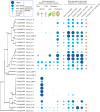Integrative analysis of the late maturation programme and desiccation tolerance mechanisms in intermediate coffee seeds
- PMID: 29361125
- PMCID: PMC5888931
- DOI: 10.1093/jxb/erx492
Integrative analysis of the late maturation programme and desiccation tolerance mechanisms in intermediate coffee seeds
Abstract
The 'intermediate seed' category was defined in the early 1990s using coffee (Coffea arabica) as a model. In contrast to orthodox seeds, intermediate seeds cannot survive complete drying, which is a major constraint for seed storage and has implications for both biodiversity conservation and agricultural purposes. However, intermediate seeds are considerably more tolerant to drying than recalcitrant seeds, which are highly sensitive to desiccation. To gain insight into the mechanisms governing such differences, changes in desiccation tolerance (DT), hormone contents, and the transcriptome were analysed in developing coffee seeds. Acquisition of DT coincided with a dramatic transcriptional switch characterised by the repression of primary metabolism, photosynthesis, and respiration, and the up-regulation of genes coding for late-embryogenesis abundant (LEA) proteins, heat-shock proteins (HSPs), and antioxidant enzymes. Analysis of the heat-stable proteome in mature coffee seeds confirmed the accumulation of LEA proteins identified at the transcript level. Transcriptome analysis also suggested a major role for ABA and for the transcription factors CaHSFA9, CaDREB2G, CaANAC029, CaPLATZ, and CaDOG-like in DT acquisition. The ability of CaHSFA9 and CaDREB2G to trigger HSP gene transcription was validated by Agrobacterium-mediated transformation of coffee somatic embryos.
Figures





References
-
- Audic S, Claverie JM. 1997. The significance of digital gene expression profiles. Genome Research 7, 986–995. - PubMed
-
- Baena-González E, Hanson J. 2017. Shaping plant development through the SnRK1-TOR metabolic regulators. Current Opinion in Plant Biology 35, 152–157. - PubMed
-
- Bailly C. 2004. Active oxygen species and antioxidants in seed biology. Seed Science Research 14, 93–107.
Publication types
MeSH terms
Substances
LinkOut - more resources
Full Text Sources
Other Literature Sources
Molecular Biology Databases

